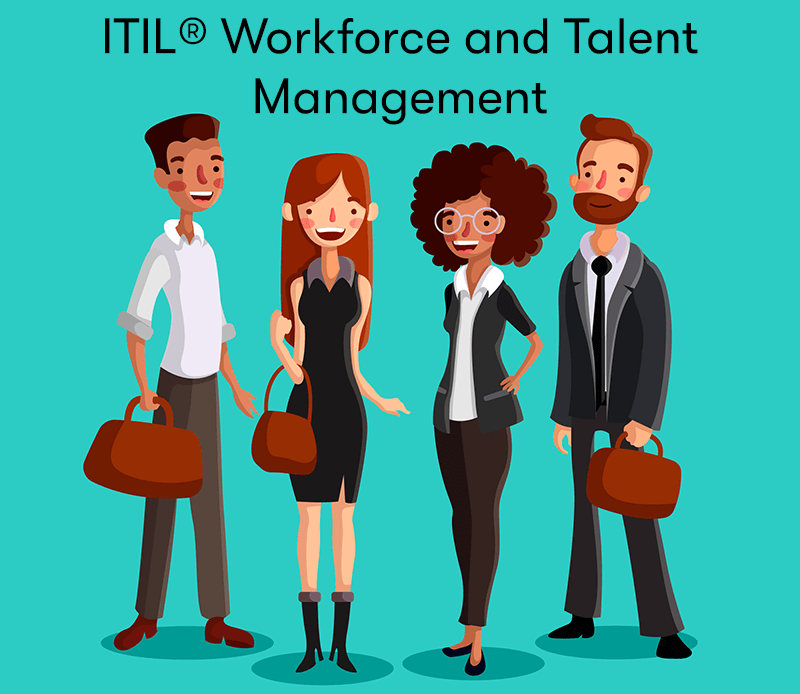ITIL® Workforce and Talent Management
Today, we'll explore the vital world of ITIL Workforce and Talent Management practice and its role within the ITIL 4 framework. As organisations strive for excellence in IT service management, the significance of skilled, engaged, and adaptable employees cannot be overlooked.
ITIL Workforce and Talent Management focus on strategically managing and developing the human resources within an IT organisation. By aligning HR practices with the organisation's vision, fostering continuous improvement, and promoting employee engagement, ITIL 4 ensures a capable and dynamic workforce that drives innovation and delivers exceptional services. Let's dive into the world of talent management and its impact on ITIL's success!
What is ITIL Workforce and Talent Management?
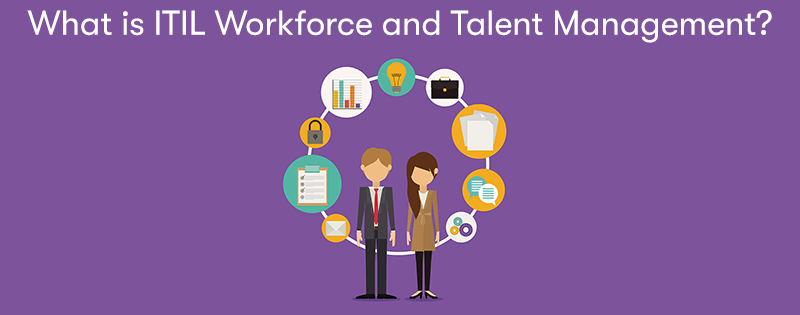
ITIL 4 Workforce and Talent Management is a key component of the ITIL 4 framework that focuses on managing and developing the human resources within an IT organisation to ensure effective service delivery and continuous improvement.
Here are some key aspects of ITIL 4 Workforce and Talent Management:
Competency Framework
ITIL 4 Workforce and Talent Management involves creating a skills and competency framework that outlines the required skills and capabilities for different roles within the IT organisation. This framework helps identify skill gaps and areas for improvement. This does not have to just be limited to your IT department and could encompass the whole of your organisation.
Training and Development
To ensure that employees have the necessary skills and knowledge to perform their roles effectively, ITIL 4 Workforce and Talent Management emphasises providing training and development opportunities. This may include both technical training (e.g., IT processes, tools, and technologies) and soft skills training (e.g., communication, problem-solving, customer service). Training is key to identifying and filling the knowledge and competency skills gaps.
Performance Management
ITIL 4 encourages the implementation of performance management practices to measure and evaluate the performance of individuals and teams. Regular performance assessments help identify areas where improvements are needed and recognise outstanding contributions.
Talent Acquisition and Retention
Attracting and retaining skilled IT professionals is crucial for IT service management. ITIL 4 Workforce and Talent Management may involve strategies for recruiting top talent and creating an engaging and fulfilling work environment to retain valuable employees.
Succession Planning
Succession planning ensures that there are suitable candidates ready to take over critical roles within the organisation in case of promotions, retirements, or unexpected departures. By identifying and developing potential successors, ITIL 4 helps mitigate risks associated with key personnel changes.
Diversity and Inclusion
ITIL 4 Workforce and Talent Management also recognise the importance of diversity and inclusion in the workplace. Embracing a diverse workforce with different perspectives and backgrounds can lead to better problem-solving and innovation.
Employee Engagement
Engaged employees are more likely to be motivated, productive, and committed to the organisation's goals. ITIL 4 encourages initiatives to boost employee engagement and foster a positive work culture.
Knowledge Management
Effective knowledge management is crucial for workforce development. ITIL 4 advocates capturing, storing, and sharing knowledge within the organisation to avoid the loss of critical expertise and improve overall performance.
It's important to note that ITIL 4 is a flexible framework, and the implementation of its practices may vary based on the specific needs and context of an organisation. As ITIL evolves and new versions are released, the approach to workforce and talent management may be refined to meet the changing demands of the IT industry. Always refer to the latest ITIL guidelines for the most up-to-date information.
ITIL®4 Workforce and Talent Management Employees’ Journey Process
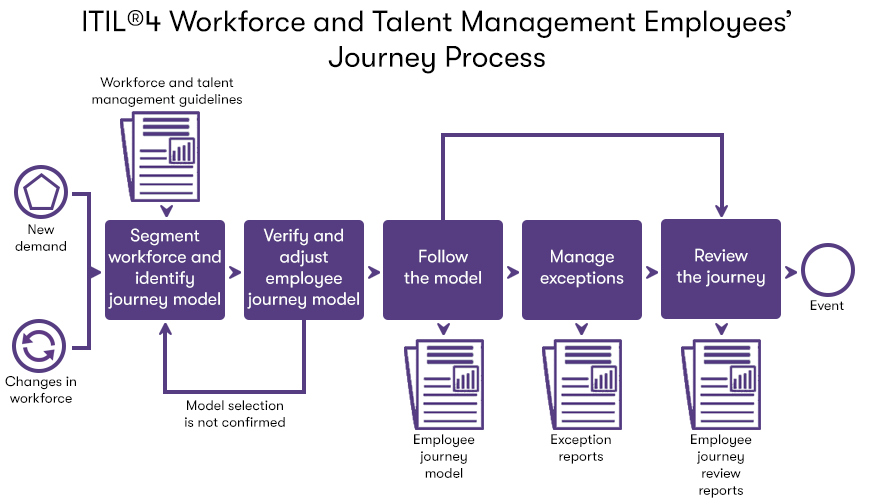
Segment The Workforce And The Employee Identify Journey Model
When a new employee is requested or there is a need to change the current employee's journey, the team manager and/or HR manager determine the employee's role and the corresponding employee journey model.
Verify And Adjust The Employee Journey Model
After selecting the model, the team manager and/or HR manager review and validate its suitability for the situation. If necessary, adjustments may be made to the individual journey to align it with the selected model and accommodate specific requirements.
Follow The Model
The HR and team managers adhere to the chosen model, incorporating agreed-upon modifications. This usually encompasses the following aspects, depending on the initial stage of the journey:
- Role/Job requirements
- Competency profile
- Procedures for crucial touchpoints throughout the employment journey
- Professional development opportunities and career pathways
- Other pertinent recommendations
Manage exceptions
In case of an exception during the employee journey, HR and team managers address it in accordance with the organisation's values, culture, and established practices. When appropriate, deviations from standard procedures are allowed as long as they align with the organisation's values and principles and bring value to stakeholders.
All exceptions are documented and subject to review for future reference and learning opportunities.
Review The Journey
HR and team managers conduct periodic reviews of the employee journey models, prompted by significant exceptions or on a regular basis. During these reviews, they verify or update the models, taking into account feedback received, reviewed requirements, employee journey records, and any new opportunities that may have arisen.
Talent Management Process Workflow
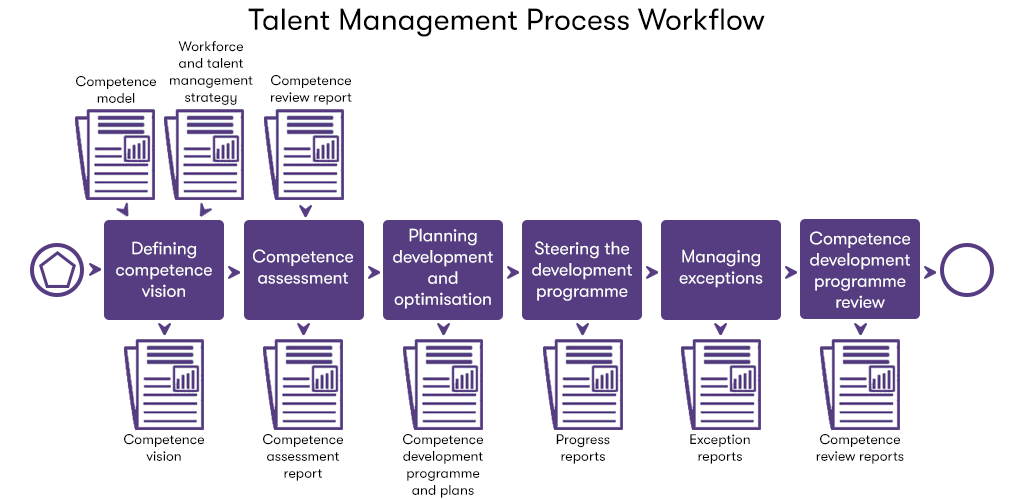
Defining A Competency Vision
Collaborating with key subject matter experts within the organisation and, if necessary, external consultants, HR managers and team managers define the organisation's vision for crucial and supporting competencies. While industry competency models may serve as additional references, the primary sources for these determinations are the organisation's own vision and strategy.
Competency Assessment
HR managers and team managers, in collaboration with key subject matter experts from within the organisation and, if necessary, external consultants, evaluate the existing competencies of the organisation's employees. During this process, they identify any gaps, potential risks, and opportunities for improvement.
In cases where resources are limited, the assessment may focus on key employees and critical competencies. Nevertheless, a comprehensive and all-encompassing approach is advised for the most thorough evaluation.
Planning Development And Optimisation
Using the results of the competency assessment, HR managers and team managers collaborate with key subject matter experts within the organisation and, if required, external consultants to design competency development programs for the organisation.
These programs are then integrated into the employee journey models and aligned with the organisation's approach to professional development.
Steering The Development Programme
HR managers take charge of overseeing and guiding the implementation of the development program, which encompasses various activities such as training and development, internal and external consulting, mentoring and coaching, periodic assessments, rotations, and other agreed-upon initiatives.
Throughout this process, records are maintained, and feedback is collected and analysed. These inputs play a crucial role in the review and updating of the competence vision for the organisation.
Managing Exceptions
In the event of an exception during the development program implementation, HR and team managers address it in accordance with the organisation's values, culture, and established practices.
When appropriate, deviations from standard procedures may be considered, as long as they align with the organisation's values and principles and deliver value to stakeholders.
All exceptions are documented and subjected to review for future reference and to derive valuable lessons from the experiences.
Competency Development Programme Review
Regularly or in response to significant exceptions, HR and team managers conduct reviews of the competency development program and vision. These reviews involve examining feedback received, reviewed requirements, employee journey records, and any new opportunities that may have arisen.
Based on the findings, they verify or update the competency development program and vision to ensure their ongoing relevance and effectiveness.
What is the Objective of Workforce and Talent Management?
The objective of Workforce and Talent Management is to strategically manage and develop the human resources within an organisation to achieve its business goals effectively. It involves identifying, acquiring, developing, and retaining the right talent, ensuring they have the necessary skills and capabilities to perform their roles optimally.
The key objectives of Workforce and Talent Management include:
Attracting and Recruiting Talent
To attract and hire skilled and qualified individuals who can contribute to the organisation's success and growth.
Developing Skills and Competencies
To provide training and development opportunities to enhance the knowledge and capabilities of employees, enabling them to perform their jobs more effectively.
Retaining Valuable Employees
To create a work environment that fosters employee satisfaction, engagement, and loyalty, reducing turnover and retaining talented personnel.
Succession Planning
To identify and groom potential successors for critical positions within the organisation to ensure continuity and mitigate risks associated with key personnel changes.
Aligning with Organisational Goals
To align workforce planning and talent development strategies with the organisation's strategic objectives to support long-term success.
Improving Performance
To continually monitor and assess employee performance, providing feedback and support for improvement and growth.
Promoting Diversity and Inclusion
To foster a diverse and inclusive work environment that values and respects the unique contributions of each employee.
Enhancing Employee Engagement
To promote a positive work culture that encourages employees to be engaged, motivated, and committed to their roles and the organisation's mission.
Knowledge Management
To capture, share, and retain critical knowledge and expertise within the organisation, preventing the loss of valuable insights and best practices.
Adapting to Changing Needs
To remain flexible and adaptive in response to evolving business requirements and market conditions, ensuring the workforce can meet future challenges effectively.
By effectively managing its workforce and talent, an organisation can build a capable, engaged, and high-performing workforce that contributes to its overall success and competitive advantage.
Why is Workforce and Talent Management Important in ITIL?
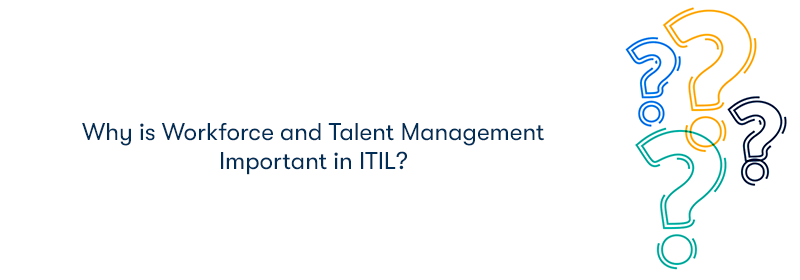
The objective of Workforce and Talent Management is to strategically manage and develop the human resources within an organisation to achieve its business goals effectively. It involves identifying, acquiring, developing, and retaining the right talent, ensuring they have the necessary skills and capabilities to perform their roles optimally.
The key objectives of Workforce and Talent Management include:
Attracting and Recruiting Talent
To attract and hire skilled and qualified individuals who can contribute to the organisation's success and growth.
Developing Skills and Competencies
To provide training and development opportunities to enhance the knowledge and capabilities of employees, enabling them to perform their jobs more effectively.
Retaining Valuable Employees
To create a work environment that fosters employee satisfaction, engagement, and loyalty, reducing turnover and retaining talented personnel.
Succession Planning
To identify and groom potential successors for critical positions within the organisation to ensure continuity and mitigate risks associated with key personnel changes.
Aligning with Organisational Goals
To align workforce planning and talent development strategies with the organisation's strategic objectives to support long-term success.
Improving Performance
To continually monitor and assess employee performance, providing feedback and support for improvement and growth.
Promoting Diversity and Inclusion
To foster a diverse and inclusive work environment that values and respects the unique contributions of each employee.
Enhancing Employee Engagement
To promote a positive work culture that encourages employees to be engaged, motivated, and committed to their roles and the organisation's mission.
Knowledge Management
To capture, share, and retain critical knowledge and expertise within the organisation, preventing the loss of valuable insights and best practices.
Adapting to Changing Needs
To remain flexible and adaptive in response to evolving business requirements and market conditions, ensuring the workforce can meet future challenges effectively.
By effectively managing its workforce and talent, an organisation can build a capable, engaged, and high-performing workforce that contributes to its overall success and competitive advantage.
How OpusView can Help With Workforce and Talent Management
The accurate tracking and recording of the skills and competencies for 10’s, hundreds, thousands or even tens of thousands of employees can be a nightmare task. But accurate data held in a central repository is vital for an efficient and successful organisation. OpusView provides a solution to address this problem and provides at a touch concise and accurate workforce and talent management data to line management, HR, Learning and development managers and project managers, in fact anyone that needs to ensure that the right people with the right skills and competencies are in the right place at the right time to support critical business processes.

What is Important to Understand About ITIL Workforce and Talent Management?
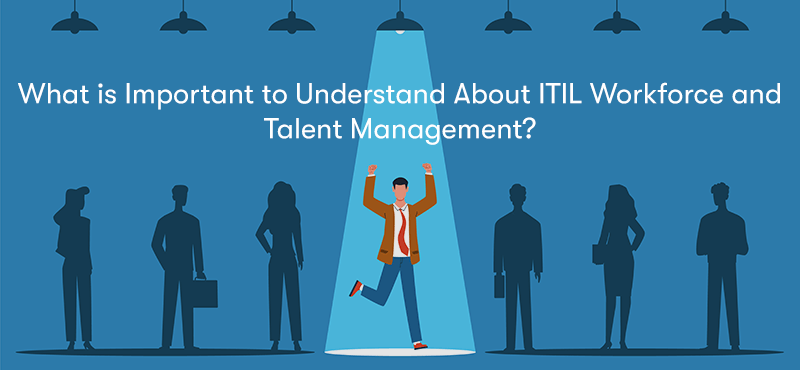
Understanding ITIL Workforce and Talent Management is essential for organisations that aim to implement ITIL practices successfully and achieve effective IT service management. Here are some key points to consider:
Strategic Alignment
ITIL Workforce and Talent Management should align with the organisation's overall business strategy and objectives. The competencies and skills of the IT workforce should be tailored to support the specific needs and goals of the organisation.
Continuous Improvement
Workforce and Talent Management is not a one-time effort but an ongoing process. It should focus on continually developing the capabilities of employees, identifying skill gaps, and adapting to changes in the IT landscape.
Integration with Employee Journey
Workforce and Talent Management should be integrated into the employee journey models. It should encompass various stages, such as recruitment, onboarding, training, development, performance management, and career advancement.
Employee Engagement
Engaging and motivating employees is crucial for effective Workforce and Talent Management. Providing opportunities for growth, recognising achievements, and fostering a positive work culture can boost employee morale and productivity.
Knowledge Management
Capturing and sharing knowledge is essential to avoid the loss of critical expertise and to facilitate organisational learning. Effective knowledge management is a key aspect of Workforce and Talent Management.
Flexibility and Adaptability
The IT industry is dynamic, and workforce requirements may change rapidly due to technological advancements or shifts in business needs. Workforce and Talent Management should be flexible enough to respond to these changes.
Talent Retention
Retaining skilled employees is vital for organisational stability and continuity. Effective Workforce and Talent Management strategies should include measures to retain valuable talent and reduce turnover.
Collaboration and Expertise
Successful Workforce and Talent Management require collaboration between HR managers, team managers, subject matter experts, and, if needed, external consultants. Leveraging expertise from different areas enhances the effectiveness of talent management initiatives.
Supporting ITIL Implementation
Workforce and Talent Management play a significant role in supporting the successful implementation of ITIL practices. Skilled and well-trained employees are more likely to adopt and embrace ITIL principles and processes.
Regular Reviews and Updates
Workforce and Talent Management practices should be periodically reviewed and updated based on feedback, performance assessments, and changing organisational needs. This ensures that talent management strategies remain relevant and effective.
Workforce and Talent Management Roles and Responsibilities
In ITIL 4 Workforce and Talent Management, various roles and responsibilities contribute to the effective management and development of the IT workforce. The specific roles and responsibilities may vary depending on the organisation's size, structure, and the maturity of its talent management practices. Here are some key roles and their associated responsibilities:
HR Manager:
- Develop and implement talent management strategies aligned with the organisation's objectives.
- Oversee recruitment and onboarding processes to ensure the right talent is acquired.
- Identify training and development needs and coordinate relevant training programs.
- Establish performance management systems and conduct regular performance assessments.
- Design and manage career development and succession planning initiatives.
- Promote employee engagement and foster a positive work culture.
- Address HR-related issues and provide support to employees.
Team Manager/Team Leader:
- Participate in the talent acquisition process by providing input on required skills and competencies for team members.
- Support the development of team members by identifying their training needs and providing coaching and mentoring.
- Monitor and assess team members' performance and provide feedback for improvement.
- Encourage a collaborative and learning-oriented team environment.
- Identify high-potential employees for career growth and succession planning.
Subject Matter Experts (SMEs):
- Contribute to competency framework development by identifying the required skills and knowledge for specific roles.
- Provide expertise in creating training materials and conducting training sessions.
- Collaborate with HR and team managers to assess employees' skill levels and identify development opportunities.
- Offer guidance and support to employees in their areas of expertise.
- Participate in talent reviews and succession planning discussions.
Employees:
- Actively participate in talent development activities, such as training and development programs.
- Seek opportunities for professional growth and skill enhancement.
- Engage in performance discussions with managers and seek feedback for improvement.
- Contribute to knowledge sharing and collaboration within the organisation.
- Participate in career development discussions and succession planning initiatives.
External Consultants (if applicable):
- Provide specialised expertise in talent management practices and strategies.
- Assist in competency framework development and talent assessments.
- Conduct training and development sessions for employees.
- Offer insights and best practices from other organisations or industries.
- Support the implementation of talent management initiatives.
It's essential for organisations to define and communicate the specific roles and responsibilities clearly within their context to ensure a coordinated and effective approach to ITIL 4 Workforce and Talent Management. Additionally, regular collaboration and communication among these roles are critical for the successful implementation of talent management strategies.
Final Notes on Workforce and Talent Management for ITIL
In conclusion, ITIL 4 Workforce and Talent Management play a pivotal role in driving the success of IT service management. By strategically aligning HR practices with the organisation's vision, fostering a culture of continuous improvement, and promoting employee engagement, businesses can harness the full potential of their IT workforce.
Effective talent management ensures that the right skills are in place to adapt to changing technologies and industry demands, driving innovation and customer satisfaction. Regular reviews and collaboration among HR managers, team leaders, and subject matter experts enable organisations to stay agile and competitive in the ever-evolving IT landscape.
Embracing these principles empowers organisations to achieve their ITIL goals and deliver exceptional services to their customers.


